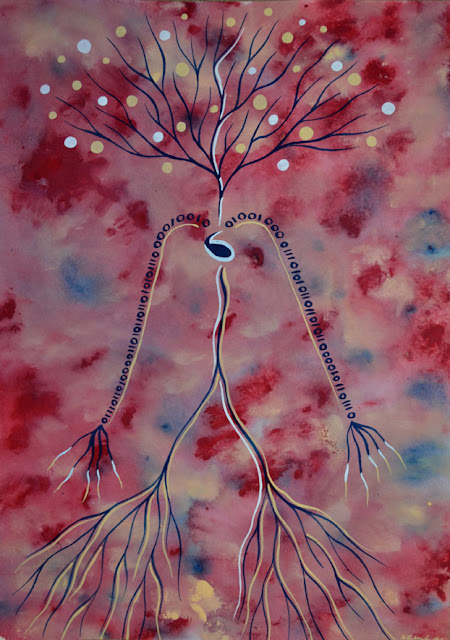My Future Posthuman Gouache and watercolour on paper 42 x 30 cm 2016
Regular readers will have noticed that I am having fun with the posthuman!
In my mind the posthuman is something that may happen in the future, the far distant future. I don't believe we are already posthuman. However, some people do. They believe that due to technology's mediation of minds and bodies we are no longer human and therefore we are posthuman.
Maybe we are transhuman? Some think the process of becoming posthuman is an evolutionary one and that becoming transhuman is a stage through which evolution must pass. There are arguments that treatments and/or enhancements such as mind altering drugs, prosthetics and implants represent transhumanist change or alteration. Contemporary transhumanists such as Zoltan Istvan, Aubrey de Grey and Nick Bostrom suggest that humanity is compromised by its biology. They propose that technological intervention could 'cure' biological vulnerabilities that cause aging, death and sickness. There's political agency in this proposition! Indeed, Zoltan Istvan is a current US presidential candidate for the Transhumanist Party These types of transhumanists see technological intervention and alteration of the human as enhancing the human experience. Whereas, other transhumanists [or those who think about transhumanism] particularly from the arts/humanities see transhumanism as a way to re-create or re-invent the self.
But, let's get back to the posthuman.
I think the major difference between the transhuman and the posthuman is that the former is more about enhancing the human, but the latter is more about replacing the human. I enjoy thinking about what a posthuman might be like and what kind of 'existence' a posthuman might experience. So, I imagine an era where no humans remain, due to extinction caused be either our own hands or natural means, such as the sun's tumultuous demise. In the place of humans are machines that appear to have garnered the ability to mimic human modes of being. However, these modes are greatly augmented - so much so that abilities far exceed human ones - to the point where human-ness is almost indiscernible. These machines 'exist' on a far away exo-planet, having escaped Earth - or maybe humans sent them off to investigate alternative planetary homes, but not in time to actually save humanity?
BUT, maybe there are no tangible presences? Instead only an awareness of downloaded minds, harvested from humans, even those stored in cryogenic facilities for centuries. These downloaded minds trip around the universe on light beams aided by algorithms that replicate and continually enhance.
My Future Posthuman
In my new painting above I imagined me [or my mind] as a posthuman. But, I also decided that I could paint an imaginary friend, my posthuman imaginary friend. Indeed, perhaps I've unwittingly painted the posthuman being who is operating me as a simulation? Yep, you read right! This idea stems from Nick Bostrom's simulation argument. Please read Are You Living In A Computer Simulation? This certainly turns the whole idea of the posthuman upside down, because Bostrom suggests that if we are living in a computer simulation, it is being run by posthumans. Does that mean we are already posthuman, even if we are only simulated?
So - in My Future Posthuman I've painted a figure with tree-like appendages, a multicoloured heart and a head shaped like a question mark - but the question mark is formed from two rows of binary code 'instructing' the word 'Human'. Hence, the question mark! I love the tree-like wings that spring from the figure's shoulders. They and the tree-like appendages connect the figure to the outer reaches of the universe, of time and space. Regular readers will identify the trees as my visual re-interpretation of the age/old transcultural/religious tree-of-life symbol. I don't think this symbol's potency has been exhausted. That's why I gain a contrary enjoyment in juxtapositioning it with binary code. Both 'codes' have instructional qualities, although they may suggest alternative paths, which may or may not cross.
Worth looking into though!
Cheers,
Kathryn
www.kathrynbrimblecombe-fox.com







